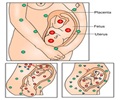
Shawn Noren from the Institute of Marine Science, University of California Santa Cruz, joined a pod of dolphins at Dolphin Quest, Hawaii, just before two of the females gave birth.
She analysed the impact of pregnancy on the animals' streamlined shape and mobility.
"The pregnant females had huge protrusions where the fetus was sitting towards the back end of the body," said Noren, who donned Scuba gear and spent a large portion of the final fortnight of the dolphins' pregnancies filming under water as they swam parallel to her camera between their trainers.
Noren also filmed the dolphin mothers immediately after their calves were born and at regular intervals until the calves were 2 years old.
Comparing the footage before and after delivery, Noren realised that pregnant females were slower.
Advertisement
"Two to three metres per second is a comfortable speed for most bottlenose dolphins but these pregnant animals did not feel comfortable going beyond that."
Advertisement
And when Noren measured the drag experienced by the animals as they glided through the water, she discovered that it doubled when the mothers were close to delivery.
Manually digitising the position of the animals' flukes (tail fins) as they beat up and down, Noren discovered that the pregnant females were unable to sweep their flukes as far as they could after birth.
They had reduced the amplitude of their tail beat by 13 percent and they compensated for the reduced propulsion by beating their flukes faster. The pregnant dolphins had changed gait.
The study has been published in The Journal of Experimental Biology.
Source-ANI















